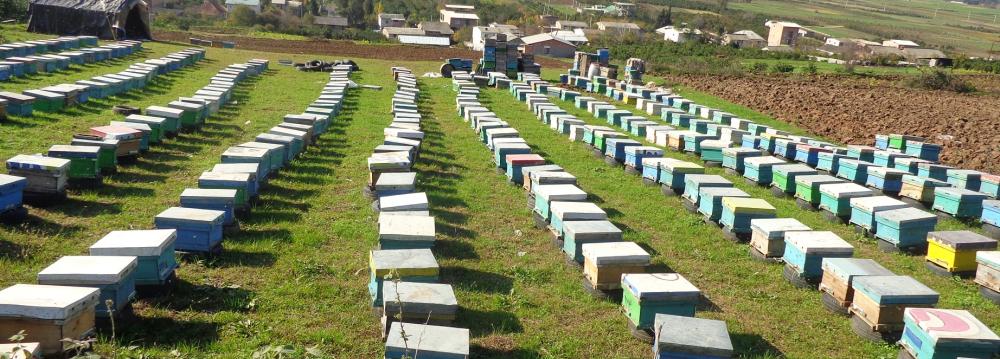Beekeeping in Iran dates back to 2,000 to 3,000 years, though apiculture as we know it in its modern, industrial form started around three decades ago in Iran. Since then, the number of beekeepers and the amount of honey produced are increasing year by year.
“Last [Iranian] year (ended March 20, 2017), more than 81,000 tons of honey were produced across the country, registering a 5.3% increase compared with the year before,” deputy agriculture minister for livestock affairs, Hassan Rokni, told Financial Tribune in an interview.
One of a Kind
According to Rokni, last year, some 1,500 tons of honey were exported from Iran.
Exports in the first three months of the current year (March 21-June 20) stood at close to 205 tons. The main export destinations for Iranian honey are Turkey, the littoral states of the Persian Gulf and the Eurasian countries.
West Azarbaijan with over 21,000 tons, East Azarbaijan with around 13,000 tons and Ardabil with 6,000 tons top the list of Iranian provinces where honey is produced.
“We enjoy a variety of flora in different regions of Iran. Each province presents us with its specific combination of flora. Technically speaking, the more wide-ranging the flora in a region, the more nutritious the honey and the more its healing effects. Therefore, the honey produced in our country has this very unique quality. Iranian honey has its fans both inside the country and abroad,” he said.
Average honey production in each modern Iranian hive, the official added, amounts to around 11 kilograms while that of a traditional hive holds about 5 kilograms.
“Based on the latest census, there are more than 7.45 million honeybee colonies in Iran. The country ranks fourth in the number of honeybee colonies worldwide, but eighth in honey production. This is because our average honey production per hive is relatively low. The Ministry of Agriculture plans to increase this figure to satisfactory levels,” he said.
At present, per capita honey production in Iran stands at 1.02 kilograms while per capita consumption is 990 grams.
According to Rokni, the average global per capita consumption is 250-300 grams.
Making Headway
“We have tried, over the past two to three years to increase the income of our more than 78,000 beekeepers. As such, apart from honey, we have focused on the production of pollen and royal jelly. These are valuable products not only in pecuniary terms, but in the role they play in curing many ailments and diseases,” he said.
Royal jelly is priced at 50 million rials (more than $1.322) per kilo in the domestic market. Each kilogram of honey is priced at an average of $5-6 in the global market.
Classes are also being administered on how to increase royal jelly and honey production per hive. Bee farmers are being trained on the best time for hive relocation, which is an important step in the production process.
“With the help of the Apiculture Expansion Support Fund, we have been able to provide some of the required bee feeds as well as medicines to fight off diseases and pests. The fund has also provided beekeepers with sugar that helps bees survive in wintertime,” he said.
Over the past three decades, Rokni says, measures have been taken to convert traditional hives to modern ones and currently 95% of all Iranian beehives are modern. Moreover, the selective breeding of queen bees has also been carried out to produce more populated colonies.
Setbacks
The official points out to the chronic problem of packaging that afflicts almost all Iranian products from saffron to fruits and nuts. He said the Iranian honey industry is also a victim of poor packaging, which is a major issue when it comes to exports.
Another problem, he added, pertains to the price of honey in the international market.
“We should be able to reduce production expenses so as to compete globally with respect to prices,” he said.
Moreover, says Rokni, there’s the issue of organic honey.
“It is estimated that some 5% of the honey produced in Iran are organic. Yet, unfortunately, these are not distinguished from other kinds in the absence of special brands and packaging or different price ranges,” he said.
Seeking APIMONDIA Membership
The 45th APIMONDIA International Agricultural Congress, where representatives of beekeepers’ associations from around the world come together, is scheduled to be held from September 29 to October 4 in Istanbul, Turkey.
“We will attend the congress and pursue our membership in APIMONDIA, the International Federation of Beekeepers’ Association,” he said.
The official noted that apiculture has a major role to play in the bigger scheme to boost agricultural products in quantity and quality through the pollination carried out by bees.
“In many countries, bee colonies are usually placed in farms for this effect, yet, in Iran this seems to be a problem. We need to build the culture for this to happen,” he said.
Rokni also said producers of beekeeping equipment are active in Iran and are now exporting their products.
“We possess the technology in manufacturing the required equipment; yet we lag behind in production technology. We have got work to do in this regard,” he said.



